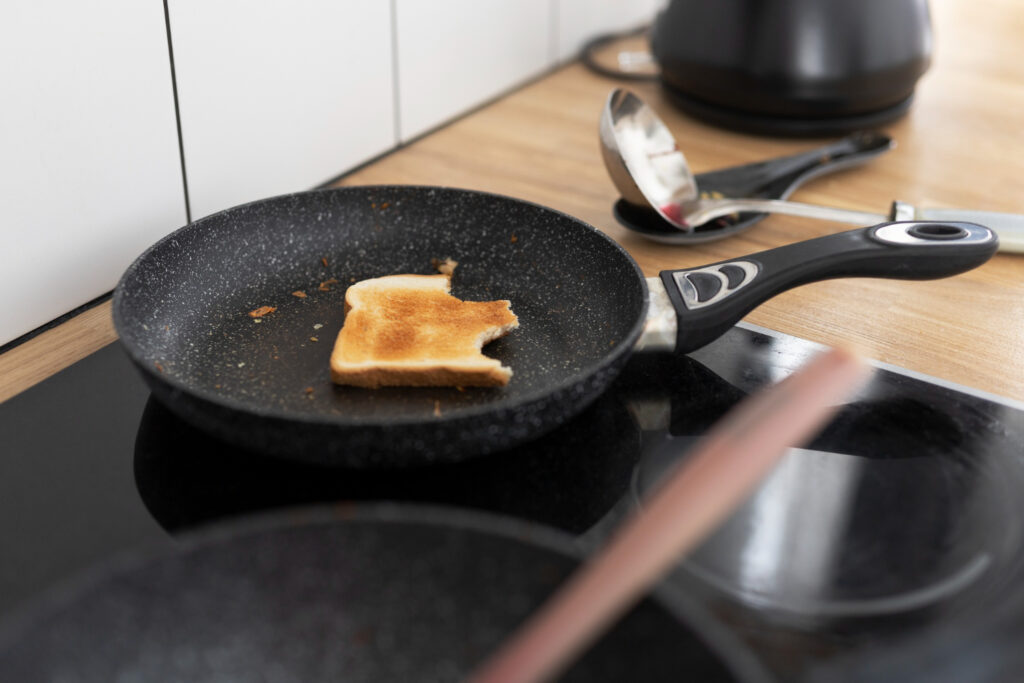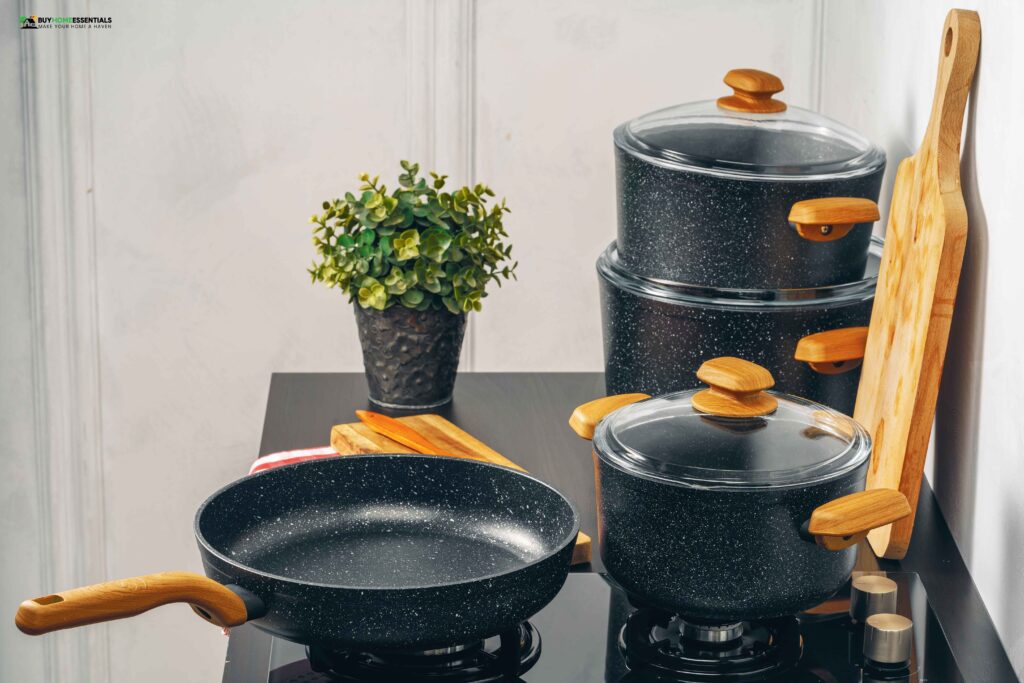Are you considering upgrading your cookware and exploring your options? Recently, ceramic cookware has become a popular choice when it comes to equipping your kitchen. This guide explores the pros and cons of ceramic cookware so you’ll be able to determine whether it’s right for you.
The nonstick surface of ceramic cookware and its eye-catching designs make it a popular choice. It’s an attractive choice for people who want to enjoy safe and healthy cooking. There are, however, some drawbacks to this cookware, as with any other. Let’s take a look at the pros and cons of ceramic cookware.
Pros of Ceramic Cookware

Ceramic cookware has been praised for its numerous benefits, making it a preferred choice for many home cooks. Let’s dive into the advantages that set ceramic cookware apart from other options in your kitchen:
Non-Stick Surface
One of the primary reasons why people opt for ceramic cookware is its exceptional non-stick surface. This quality simplifies cooking and cleaning. With a ceramic-coated pan or pot, you’ll find that food hardly sticks, making it easier to flip pancakes, sauté vegetables, and sear meats without the hassle of stuck-on residue. Plus, it allows for healthier cooking as you can use less oil or butter, reducing overall fat intake in your meals.
Excellent Heat Retention
Ceramic cookware boasts excellent heat retention and distribution properties. This means that it heats evenly across the entire cooking surface, preventing hot spots that can lead to unevenly cooked dishes. Whether you’re simmering a delicate sauce or searing a steak, ceramic cookware ensures your food cooks uniformly, resulting in better-tasting meals.
Safe and Healthy
Ceramic cookware is often lauded for its safety. Unlike some non-stick coatings that may release harmful chemicals when heated, ceramic is non-toxic. You can cook with peace of mind, knowing that it won’t leach potentially harmful substances into your food. This feature makes it an excellent choice for health-conscious individuals and families.
Versatility
Ceramic cookware is versatile and suitable for a wide range of cooking methods. Whether you’re using it on the stovetop, in the oven, or under the broiler, it can handle the heat. Many ceramic cookware sets include various pieces like pots, pans, and baking dishes, ensuring you have the right tool for the job, no matter the recipe you’re tackling.
Aesthetic Appeal
Beyond its functionality, ceramic cookware often comes in a variety of attractive and colorful designs. This makes it an appealing addition to your kitchen decor. The vibrant and stylish options can elevate the visual appeal of your culinary space, and some sets are so beautiful that they can be taken straight from the stove to the dining table for a stunning presentation.
There are several advantages to ceramic cookware, making it an excellent choice for those seeking easy and healthy cooking. In the next section, we’ll explore the drawbacks and considerations of each, too.
Cons of Ceramic Cookware

While ceramic cookware has numerous advantages, it has its drawbacks. Understanding the limitations of ceramic cookware is essential to make an informed decision about whether it suits your cooking needs:
Fragile
One of the most significant drawbacks of ceramic cookware is its fragility. The ceramic coating, while excellent for its non-stick properties, can be easily chipped or scratched. Using metal utensils or abrasive scrubbers can damage the surface. To prolong the lifespan of your ceramic cookware, you’ll need to handle it with care. Consider using utensils made of wood, silicone, or nylon to avoid unnecessary damage.
Not Ideal for High Heat
While ceramic cookware excels in even heat distribution at moderate temperatures, there are better choices for high-heat cooking methods like searing or broiling. Exposing ceramic cookware to extreme temperatures can cause it to lose its non-stick properties and may lead to discoloration or warping. For tasks that require high heat, consider alternative cookware materials, such as cast iron or stainless steel.
Seasoning Required
To maintain the non-stick properties of ceramic cookware, it’s essential to season it regularly. Seasoning involves applying a thin layer of oil and heating the cookware to bond the oil to the surface. This process creates a natural non-stick barrier. While it’s not as intensive as seasoning cast iron, it’s an additional step to consider when using ceramic cookware.
Learn More: How to Season Ceramic Cookware
Price
In comparison to other cookware materials like stainless steel or non-stick coated pans, ceramic cookware can be more expensive. It may not be suitable for all budgets. However, you should consider the benefits it offers, including safety, durability, and style. When evaluating the price, consider how often you cook and what you make.
Making an informed decision requires understanding both the advantages and disadvantages of ceramic cookware. Several benefits of this appliance make it an appealing option for many home chefs. Knowing its limitations will help you make the most of it in the kitchen.
How to Maintain and Care for Ceramic Cookware
Caring for your ceramic cookware is crucial to ensure it continues to perform at its best and maintains its longevity. Here are some tips for proper maintenance and care:
- Hand Washing: It’s best to hand wash your ceramic cookware rather than using a dishwasher. While some ceramic-coated pans claim to be dishwasher-safe, the high water temperature and harsh detergents in dishwashers can deteriorate the non-stick surface over time. Use a soft sponge or cloth and mild dish soap to clean your ceramic cookware gently.
- Avoid High Heat: As mentioned in the cons section, ceramic cookware is not designed for high-heat cooking. To prevent damage, use low to medium heat settings on your stovetop. It’s also a good practice to allow the cookware to cool down gradually after cooking to avoid thermal shock, which can lead to cracks or warping.
- Seasoning: Regularly seasoning your ceramic cookware helps maintain its non-stick properties. To season, apply a thin layer of cooking oil to the interior and heat it over low to medium heat for a few minutes. This process should be repeated occasionally, depending on your usage and the manufacturer’s recommendations.
- Use the Right Utensils: To avoid chipping or scratching the ceramic coating, use utensils made of wood, silicone, or nylon. Avoid metal utensils that can damage the surface. Wooden or silicone spatulas and non-abrasive cleaning pads are ideal choices.
- Stacking and Storage: When storing your ceramic cookware, avoid stacking pieces on top of each other without protection. Placing a soft cloth or paper towel between nested pans can prevent potential chipping. Additionally, ensure that the cookware is completely dry before stacking or storing to prevent moisture-related damage.
- Check the Manufacturer’s Guidelines: Different brands and types of ceramic cookware may have specific care instructions provided by the manufacturer. Always follow their guidelines to maintain the integrity of your cookware.
Read More: How to Clean Ceramic Cookware
The Takeaway
Ceramic cookware stands out as a unique and popular choice for many home cooks. Its non-stick surface, excellent heat retention, safety, and versatility make it an appealing choice for the kitchen. Additionally, ceramic cookware adds a touch of aesthetic appeal to your kitchen.
However, ceramic cookware needs more high-heat capabilities, requires seasoning, and is potentially more expensive. You should make your choice based on your cooking style and preferences.





